- Home
- Keith R. A. DeCandido
War Stories: Book One Page 6
War Stories: Book One Read online
Page 6
“We’ve tried that in the past,” Sisko said. “But at this point, the Jem’Hadar and the Cardassians know to look for it.”
“With respect, sir, those had been changes to the shield harmonics. What I’m suggesting is altering the warp fields of the ships. We’ve tested it on the Sentinel, and it should fool even Dominion sensors at warp speeds.”
One of the Romulans sneered. “And when you come out of warp and are revealed to be a Federation ship?”
“We keep the warp field in place. As long as they don’t do an intensive scan, they shouldn’t be able to tell the difference between it and a hull configuration. In fact, we can also change the shield harmonics to match. They’re less likely to look for that bit of misdirection if the ship’s warp field reads as an allied ship.”
Ross seemed intrigued by the idea. “Can you maintain warp seven with this reconfiguration?”
Gomez blinked. She hadn’t thought of that—but then, she hadn’t known they’d be forced to maintain warp seven until two minutes ago. “I’m afraid not. We could only do warp four—any higher and the modified warp field will tear the hull apart.”
“Then it won’t be practical for this mission. Still, it’s a good idea. Send the specifications on that to the station—and,” he added with glances at Martok and the Romulan general, “we’ll share it with everyone here, see if we can make it work across the board.” He turned back to Gomez. “Good work, Commander.”
Gomez nodded, but was still disappointed. She was sure that the trick would work—but not at warp seven. She had been hoping for a practical test, and this mission would have been ideal for it.
The good news was that the route provided by the Cardassian resistance had done the trick, and the three Starfleet vessels arrived at the outpost unmolested. The other good news was that Intelligence was right, and there were only two Jem’Hadar strike ships guarding the outpost.
The rest of the news was rather bad.
For one thing, the outpost itself turned out to be armed with energy weapons of a type Gomez didn’t recognize. They plowed through the Fredrickson’s shields with little effort, leaving the Excelsior-class ship a sitting duck for the Jem’Hadar. It was destroyed within two minutes of their arrival in the sector.
“Steinberg, give me a reading on that damn weapon!” Gomez bellowed at her assistant chief.
In a voice as calm as hers was frantic, the black-haired lieutenant said, “I’m almost finished with my analysis, Commander.”
“Finish faster.” She gazed at the viewscreen that showed what the bridge had on their main viewer. The Musashi had gotten some shots into the outpost before one of the Jem’Hadar ships cut them off. Now each ship had the Jem’Hadar on their tail, with the outpost itself taking potshots as well.
The Sentinel’s shields were now down to twenty percent.
Patel’s voice sounded over the comm systems. “Divert power to shields.”
In addition to getting their new assignment, the Sentinel had gotten crew replacements at DS9. One of them, a kid who didn’t look old enough to be let out of his house alone, said, “I can’t get the power to divert to the shields!” Gomez could hear the panic in the young man’s voice.
“Take it from wherever you need it, Ensign, just keep the shields up.”
“No, it’s not that—the control circuits are fused.”
Gomez rolled her eyes. “If you can’t reprogram, reroute.”
The ensign nodded quickly. “Right, of course. Sorry, Commander.”
“Just keep your head cool.” Was I ever that young and stupid? Gomez thought.
“Commander,” Steinberg said, “if we bring the shield frequency down to the lower regions, we should be able to defend against the outpost’s weapon.”
“Lower?”
“Yes, sir.”
It was a counterintuitive move—which, no doubt, was the Dominion’s thinking.
The baby ensign said, “Shields back up to eighty percent.”
“Nice work,” Gomez said. “Steinberg, bring the frequency down.”
“Aye,” the lieutenant said.
She tapped her combadge. “Bridge, we’re lowering shield frequency—that should allow us to defend against the outpost. Recommend transmitting data to the Musashi immediately.”
“Acknowledged,” Patel said. “Good job, Gomez.”
The Jem’Hadar ship then fired on them again, pounding at the shields.
“At this frequency,” Steinberg said, “we’ve got to keep them at sixty percent, or the Jem’Hadar will rip us to pieces.”
Gomez went through the mental picture of the Sentinel in her head. The Akira-class ship had a compact, retro design, reminiscent of the old pre-Federation Earth starships. There wasn’t a lot of wasted space. Still…
“Bridge, we need to evac decks eight, nine, and ten right away.” Those were crew quarters, holodecks, and recreational facilities—none of them necessary right now, and only minimal staff was there at present.
Amalfitano and Patel, bless their hearts, didn’t even question the request. “Attention all hands,” Amalfitano said. “This is the captain. Evacuate decks eight, nine, and ten immediately.”
“Steinberg, the second everyone’s out of those decks, cut off all power, and divert as much of it as you can to the shields.” Silently, Gomez cursed whichever idiot designer thought it was a good idea to make holodeck systems incompatible with other ship systems. We really could use that power right now. But at least the other power that was used for those decks would be put to good use.
Chatter from the bridge came over the intercom.
“Continuous fire on the Jem’Hadar.”
“Their aft shields are failing.”
“Concentrate fire there, Grimnar.”
“Aye, sir.”
“Tenmei, bring us to 253 mark 9, try to drive a wedge between them.”
“Direct hit—our shields are down to sixty-five percent.”
Steinberg looked at Gomez. “Sir, we can’t keep this up—if we stick with the lower frequency, we’re more vulnerable to the Jem’Hadar.”
“We’re not exactly overburdened with options,” Gomez said.
“Shields are down.”
Gomez turned. “What the hell happened?”
Steinberg checked a console. “Lucky shot—they got through to one of our emitters.”
“The Jem’Hadar don’t rely on luck,” Gomez said. “And neither do we—reroute, get the shields back up to full. Are those three decks evacuated yet?”
“Not yet.”
“We can’t wait, divert the power.”
“Aye, sir.”
Even on as small a ship as the Sentinel, there was considerable waste in the life support system. Even with it taken off-line, there would be enough air just sitting in the corridors to last a couple of hours, and at red alert, they’d probably all have wristlamps in any case. And if they don’t, that’s just too damn bad, she thought, a bit unkindly. They should’ve evac’d by now.
The young ensign—whose name, she finally remembered, was Natale—said, “Shields back up to full. Sir, this juryrig won’t last, request permission to rewire junction 92A5.”
Gomez frowned, then smiled. “Good idea.” That junction was a backup for holodeck systems, and could easily accommodate a shield rerouting, at least for a couple of hours. It would take a few minutes, but the present setup would hold in the meanwhile.
“Thank you, sir.” Ensign Natale moved off, grinning with an enthusiasm that Gomez remembered seeing in the mirror back when she was the dumb young ensign and Geordi La Forge was the chief engineer doling out praise only when earned.
She often missed those days on the Enterprise. She had so many good friends there—Lian T’su, Reg Barclay, Gar Costa, Wes Crusher, Ella Clancy, Denny Russell. Even La Forge was more a friend than he ever really was a CO.
And, of course, Kieran. Lovable, goofy, wonderful Kieran.
One of the other engineers cried out from near the war
p core, startling her out of her all-too-brief reverie. “Commander, containment system’s fluctuating—we’ve got to take the warp drive off-line.”
Dammit, dammit, dammit. “Do it.” She tapped her combadge. “Bridge, we’ve lost warp drive.”
“Not much of an issue right now,” Patel said. “At least you got shields reenergized.”
Gomez pursed her lips. “Yeah, but our hat’s running out of rabbits.”
As if on cue, one of the Jem’Hadar strike ships exploded.
“Maybe yours is.” Gomez could visualize Patel’s toothy grin.
“Sir, the Musashi has lost shields. The other Jem’Hadar ship is moving in.”
“Tenmei, cut them off, draw their fire.”
“Aye, sir.”
The maneuver apparently worked, as the Sentinel started taking dozens more hits, from both the outpost and the Jem’Hadar. “We can’t keep this up,” Steinberg said, the first sign of tenseness creeping into an exterior that was normally a Vulcanlike calm; the noncoms had nicknamed him “T’Steinberg.”
“Easy, Steinberg, we’ll be fine.” Gomez tried to sound reassuring, but she was too busy trying to figure out what the Musashi was doing. It looked like…
No!
The Musashi was on a suicide run—headed straight for the outpost.
The Jem’Hadar realized it too, obviously, as it and the outpost both changed their firing pattern to concentrate on the Musashi.
Amalfitano’s voice cried out, “Tenmei, get between them and the Musashi. We have to give them time!”
Two seconds that seemed like hours passed, and the Musashi rammed into the Dominion outpost, annihilating it.
Sonya Gomez learned the most valuable lesson of her life shortly after she reported to the Enterprise, and the Borg carved a section out of the ship’s hull, costing the ship eighteen crew members. When she found she couldn’t get her mind around the loss of eighteen people, La Forge had said the words that she spoke now, over a decade later, to her staff:
“We’ll have time to grieve later. Steinberg, get the shields back to their regular frequency. Ensign, how’s our juryrig?”
“Almost done,” Natale called out from under a console.
“Be done, I want this ship with full defenses.”
“Grimnar,” Amalfitano was saying even as Gomez spoke, “give the Jem’Hadar everything we’ve got.”
Two seconds that actually seemed like two seconds later, the Jem’Hadar ship exploded in a satisfying conflagration, a plume of fire that was quickly consumed by the vacuum of space.
Which left the Sentinel alone amid a cloud of debris that used to be four starships and an outpost, behind enemy lines, without warp power.
“Engineering,” Patel said, “how soon can you get the warp drive up and running?”
Gomez and Steinberg walked over to inspect the warp core. “Give us a minute.”
Amalfitano said, “Make it a quick minute, Commander—the Jem’Hadar called for backup, and I really don’t want to be here when they get here.”
Grimnar’s voice cut in. “Long-range sensors are picking up a Breen ship.”
“Then we’re dead.” That, to Gomez, sounded like Ensign Simas, a notorious doomsayer whom Gomez had rotated out of the engine room due to the effect he had on morale. She wondered how the hell he contrived to get bridge duty.
She also wondered if there was some way she could change the readings that were now displayed in front of her and Steinberg.
Patel said, “Grimnar, how soon before the Breen get here?”
“At present speed, one hour, ten minutes.”
“I was afraid of that,” Gomez said. “Captain, we won’t be able to get the warp drive up and running in less than two hours.”
“What if we do a cold restart?”
Gomez couldn’t help but smile. “That estimate was with a cold restart, Captain.”
“They’ll know we’re an enemy vessel a lot sooner than that,” Grimnar said. “The debris will mask us for a little while, but the closer they get, the more likely they are to see us for what we are, in which case they may increase speed.”
“No they won’t,” Gomez said without even realizing at first why she said it. Then she spent half a second thinking it through. “Steinberg, get to work on the warp core. Natale, you’re with me—we need to bring the warp field on-line and reconfigure it.”
Natale frowned. “What’s the point of bringing the warp field on-line if we can’t go to warp? Isn’t that a huge waste of energy—especially if we don’t have the matter/antimatter system on-line?”
The ensign’s question was reasonable. Without the power provided by the constant annihilation of matter and antimatter in the core, the ship was running on emergency power. But then, Gomez thought, if this doesn’t constitute an emergency, I don’t know what does.
Before she could explain things to Natale, Amalfitano asked, “Are you thinking what I think you’re thinking, Commander?”
“Yes, Captain—we’re going to reconfigure the warp field so those Breen think we’re a Cardassian freighter.”
Patel chuckled. “I guess your idea gets a practical run-through after all, Sonya.”
“So it would seem, sir, yes.”
“Get someone up here to install the holofilter on the comm systems,” Amalfitano said. “We’re gonna need to talk our way through this, too, and I think I’ll be more convincing as a gul than a captain.”
“Yes, sir.”
Gomez sent two of her people up to the bridge, then sat down with Natale and called up her specs for the warp field reconfiguration. Natale whistled. “Impressive work, Commander, if you don’t mind my saying so.”
“I do mind, Ensign,” she said, all seriousness—then broke into a grin. “Say that again after it works.”
“Yes, sir,” Natale said, returning the grin.
Good, Gomez thought, he’s set the grief aside. He’s not thinking about all the people who’ve died today—he’s focused on what he has to do to keep himself from being added to the list. That’s the only way we’re gonna get through this.
Amazingly enough, the Breen bought it.
Gomez had been far too busy—first getting the warp field realigned, then helping Steinberg and the others get the containment unit up and running so that they could use the warp drive—to know what was happening on the bridge. All she knew was that the Breen ship went away after what she imagined was a tense fifteen minutes.
One hour and forty-seven minutes after they started, Gomez tapped her combadge and said, “Bridge, warp drive is on-line.”
“Two hours, huh?” Patel said.
“We were motivated to speed it up,” Gomez said with a relieved smile at Steinberg, who returned it.
“Good work down there,” Amalfitano said. “But keep that realigned warp field. We’re not on a timetable now, and I’m just as happy to stay at warp four if people will think we’re Cardassian.”
“No problem, Captain.”
She gave Steinberg a glance, and he nodded. “On it.”
Taking a look around at her staff, she took pride in what they had accomplished. In what she had accomplished. The idea of realigning the warp field had come to her in a night of tinkering—one of those inspirations that suddenly slams you behind the eyes. She stayed up all night working out the logistics, then brought it to Patel, who in turn brought it to Amalfitano, who told her to bring it to the meeting on DS9.
An inspiration that quite probably saved all their lives.
It wasn’t until they crossed safely back into Federation space—after being passed by several Jem’Hadar ships that didn’t challenge them—that Gomez allowed herself to feel for the hundreds of people lost on the Musashi and the Fredrickson. The grief was only slightly alleviated by the news that the strike on Orias III was successful. It was a major victory for the Alpha Quadrant.
Androssi Vessel Overseen by Biron
STARDATE 53678.9
Biron was starting to form a c
learer picture of what it was that had enabled the crew of the U.S.S. da Vinci to outwit and defeat him on two occasions. It was something he never would have deduced based on the empirical evidence he had acquired in his face-to-face encounters.
The crew of the U.S.S. da Vinci improvised.
Biron always approached every mission with a carefully laid-out plan. True, there were always variables, but rarely did they impinge upon the plan to a degree that was mathematically significant.
On the other hand, the U.S.S. da Vinci crew seemed to be able to adapt to variables with great ease. Where the variables—mostly introduced by the very presence of the U.S.S. da Vinci—on the planet Maeglin and at the space station Empok Nor had proven to be too much for Biron to overcome, his opponents seemed to thrive on it.
Perhaps it was because they were so actively involved in military engagements. While Biron did occasionally have to defend his ship and engage in battle situations, they were comparatively rare. Androssi military engagements were handled by the Elite’s standing army, supplemented as necessary by members of the worker class conscripted into service.
He would need to factor this ability into his plans.
That and the Starfleet people’s inexplicable predilection for forming personal attachments. That was a definite weakness that Biron needed to exploit.
He made a note of these items, and then continued his research…
TO BE CONTINUED…
About the Author
The co-developer of Star Trek: S.C.E., KEITH R.A. DeCANDIDO has written or cowritten five previous eBooks in the series, including the award-winning stories Fatal Error and Cold Fusion, as well as the two-book Invincible (with David Mack) and the Gateways tie-in Here There Be Monsters. He also wrote the Star Trek: The Next Generation novel Diplomatic Implausibility, the Star Trek: Deep Space Nine novel Demons of Air and Darkness, the cross-series duology The Brave & the Bold, the TNG comic book Perchance to Dream, and the DS9 novella “Horn and Ivory.” The year 2003 will see the debut of Star Trek: I.K.S. Gorkon—a sub-series that is the first to feature Star Trek’s most popular aliens, the Klingons, in a starring role—as well as a contribution to the Star Trek: The Lost Era miniseries, and more S.C.E. eBooks. In addition to all of this, Keith has written novels, short stories, and nonfiction books in the universes of Buffy the Vampire Slayer, Doctor Who, Farscape, Gene Roddenberry’s Andromeda, Marvel Comics, Xena, and much more. He is the editor of the original science fiction anthology Imaginings and the author of the upcoming novel Dragon Precinct, which mixes high fantasy with police procedurals. Find out evil rumors about him by checking his official Web site at DeCandido.net, and start a few by joining his official fan club at www.kradfanclub.com. He has long since abandoned the outmoded notion of “sleep.”

 Alien
Alien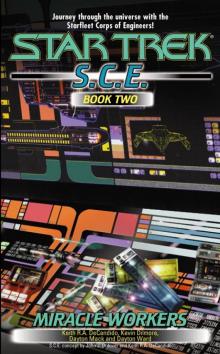 Miracle Workers
Miracle Workers Articles of the Federation
Articles of the Federation Supernatural Heart of the Dragon
Supernatural Heart of the Dragon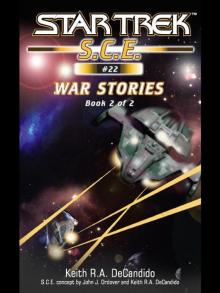 War Stories: Book Two
War Stories: Book Two The Zoo Job
The Zoo Job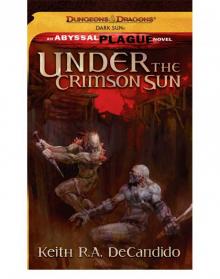 Under the Crimson Sun
Under the Crimson Sun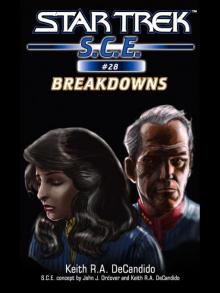 Breakdowns
Breakdowns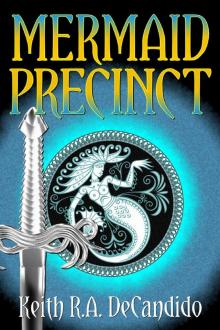 Mermaid Precinct (ARC)
Mermaid Precinct (ARC) Supernatural 1 - Nevermore
Supernatural 1 - Nevermore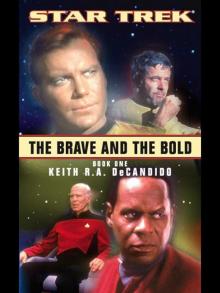 STAR TREK - The Brave and the Bold Book One
STAR TREK - The Brave and the Bold Book One Four Walls
Four Walls The Klingon Art of War
The Klingon Art of War Blackout
Blackout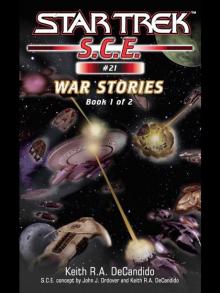 War Stories: Book One
War Stories: Book One The Brave and the Bold Book Two
The Brave and the Bold Book Two Honor Bound
Honor Bound Sleepy Hollow: Children of the Revolution
Sleepy Hollow: Children of the Revolution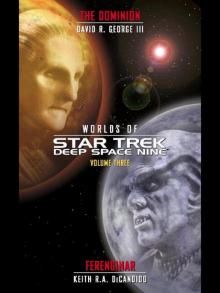 Worlds of Star Trek Deep Space Nine® Volume Three
Worlds of Star Trek Deep Space Nine® Volume Three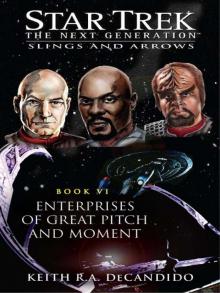 Star Trek: TNG: Enterprises of Great Pitch and Moment
Star Trek: TNG: Enterprises of Great Pitch and Moment Genesis
Genesis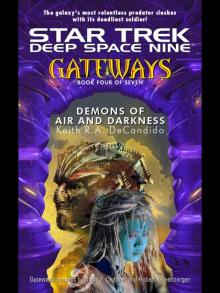 Demons of Air and Darkness
Demons of Air and Darkness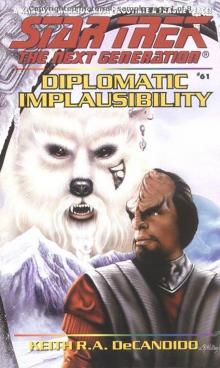 Star Trek - TNG - 61 - Diplomatic Implausibility
Star Trek - TNG - 61 - Diplomatic Implausibility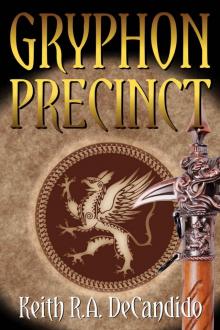 Gryphon Precinct (Dragon Precinct)
Gryphon Precinct (Dragon Precinct) THE XANDER YEARS, Vol. 1
THE XANDER YEARS, Vol. 1 Nevermore
Nevermore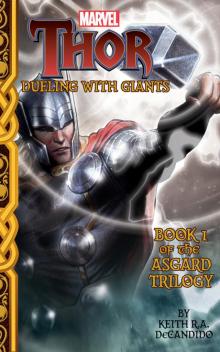 Thor
Thor The Brave And The Bold Book One
The Brave And The Bold Book One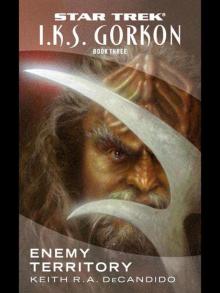 I.K.S. Gorkon Book Three
I.K.S. Gorkon Book Three STARGATE SG-1: Kali's Wrath (SG1-28)
STARGATE SG-1: Kali's Wrath (SG1-28) Bone Key
Bone Key Guilt in Innocece
Guilt in Innocece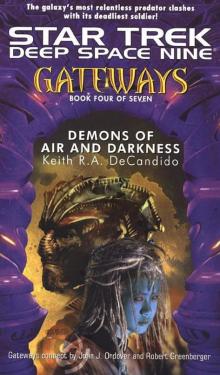 Star Trek - DS9 Relaunch 04 - Gateways - 4 of 7 - Demons Of Air And Darkness
Star Trek - DS9 Relaunch 04 - Gateways - 4 of 7 - Demons Of Air And Darkness The Art of the Impossible
The Art of the Impossible I.K.S. Gorkon Book One: A Good Day to Die
I.K.S. Gorkon Book One: A Good Day to Die Under the Crimson Sun (the abyssal plague)
Under the Crimson Sun (the abyssal plague)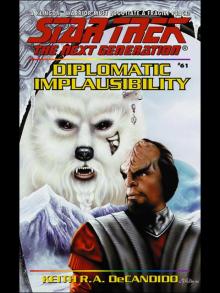 DIPLOMATIC IMPLAUSIBILITY
DIPLOMATIC IMPLAUSIBILITY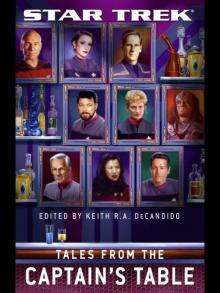 Tales from the Captain's Table
Tales from the Captain's Table A Burning House
A Burning House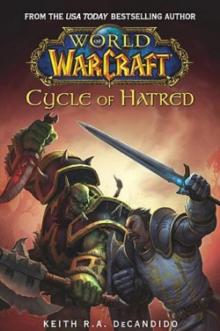 Cycle of Hatred (world of warcraft)
Cycle of Hatred (world of warcraft)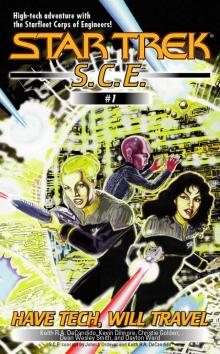 Have Tech, Will Travel
Have Tech, Will Travel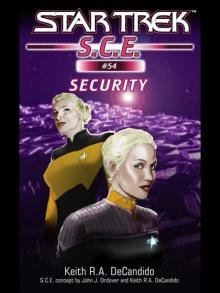 Security
Security